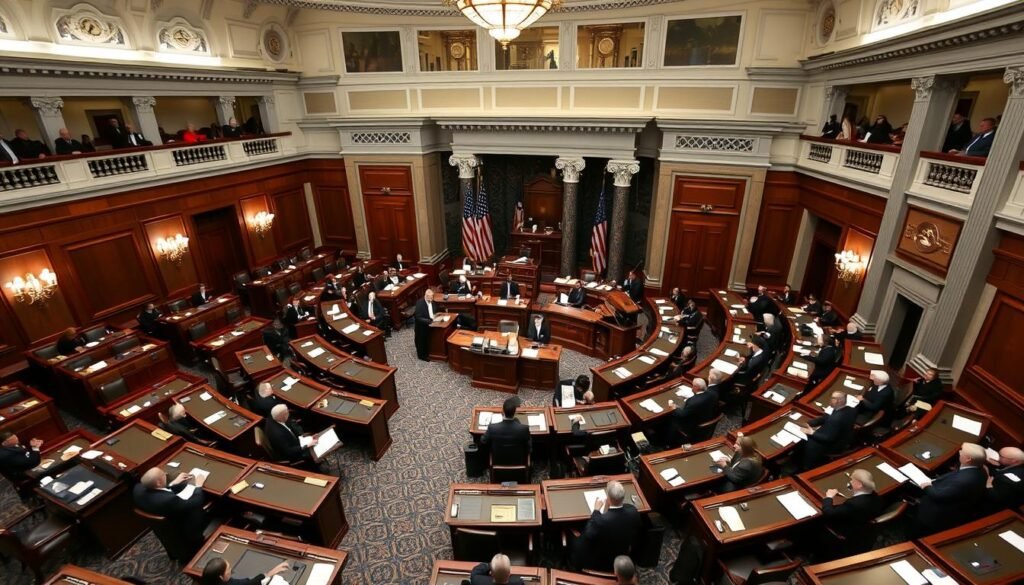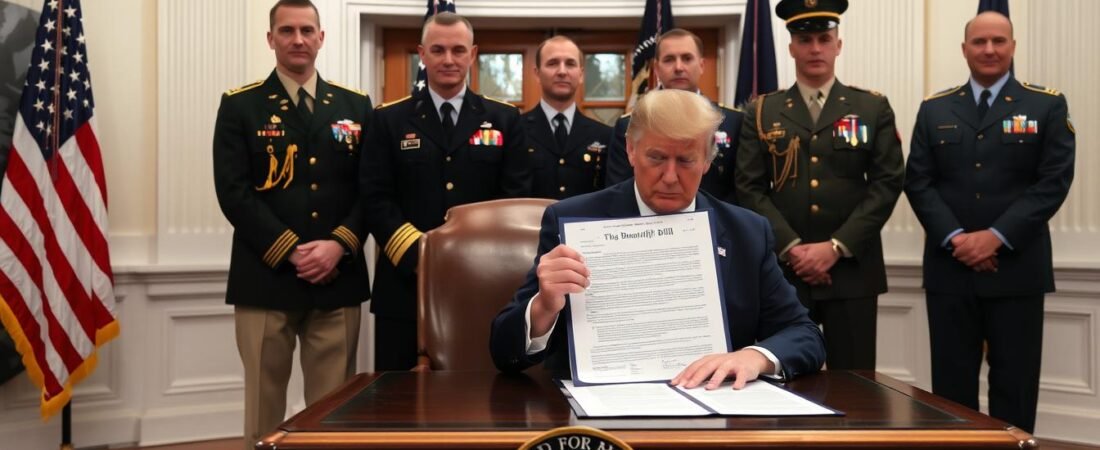The U.S. defense budget under Trump’s proposed “Big Beautiful Bill” is set to soar with a $150 billion increase for military spending, raising critical questions about America’s defense priorities and fiscal sustainability. As the bill passes through Congress, lawmakers and experts remain divided on whether this military funding surge represents a strategic necessity or an unsustainable financial commitment.
President Trump signs the “Big Beautiful Bill” with military officials present at the White House
The Military Funding Landscape in Trump’s Big Beautiful Bill
The recently passed legislation allocates $150 billion in additional funding to the U.S. military, representing one of the largest peacetime increases in defense spending in American history. This substantial boost aims to strengthen America’s military capabilities across multiple domains.
According to the Congressional Budget Office analysis, the military funding increase accounts for approximately 4.5% of the bill’s total $3.3 trillion impact on federal deficits over the next decade. The defense allocation focuses on three primary areas: shipbuilding capacity enhancement, the “Golden Dome” missile defense project, and nuclear deterrence modernization.
Stay Informed on Defense Policy
Get expert analysis on how defense spending affects national security and your tax dollars.
Historical Context: Comparing Defense Budgets Across Administrations
To understand the significance of Trump’s military spending increase, we must examine it in historical context. The Obama administration’s final defense budget in 2017 stood at $611 billion, while the Biden administration proposed $816 billion for 2023. Trump’s new bill pushes this figure significantly higher, continuing a trend of expanding military budgets.
Dr. Lindsay Cohn, professor at the Naval War College, notes: “This increase represents a fundamental shift in how America approaches defense spending. While previous administrations gradually increased budgets, Trump’s approach represents a step-change in military investment philosophy.”
| Administration | Peak Defense Budget | % of GDP | Focus Areas |
| Bush (2001-2009) | $696B (2008) | 4.3% | Iraq/Afghanistan Wars, Counter-terrorism |
| Obama (2009-2017) | $691B (2010) | 4.7% | Asia-Pacific Pivot, Force Reduction |
| Biden (2021-2025) | $816B (2023) | 3.5% | Tech Modernization, China Competition |
| Trump (2025-) | $966B (projected) | 3.9% (projected) | Shipbuilding, Missile Defense, Nuclear |
Key Military Components of Trump’s Big Beautiful Bill
The “Golden Dome” Missile Defense Project
A centerpiece of Trump’s defense strategy is the $25 billion allocation for the “Golden Dome” missile defense system. This ambitious project aims to create a comprehensive shield against ballistic missile threats from adversaries like North Korea and Iran.
Defense analyst Dr. Thomas Karako from the Center for Strategic and International Studies explains: “The Golden Dome represents a significant technological leap in America’s missile defense capabilities. However, questions remain about its technical feasibility and cost-effectiveness compared to other deterrence strategies.”
Naval Fleet Expansion
The bill directs $29 billion toward shipbuilding initiatives, representing a 20% increase compared to the 12% boost under the Biden administration. This funding aims to expand the Navy’s fleet to counter growing Chinese maritime influence in the Indo-Pacific region.

Nuclear Deterrence Modernization
The legislation allocates $15 billion for nuclear deterrence modernization, focusing on updating America’s aging nuclear triad: land-based intercontinental ballistic missiles, submarine-launched ballistic missiles, and strategic bombers.
Expert Analysis on Defense Strategy
Receive in-depth analysis from former Pentagon officials on America’s evolving defense posture.
Congressional Crossfire: Partisan Perspectives on Military Funding

The bill’s passage through Congress revealed sharp partisan divides on military spending priorities. Republican Senator Tom Cotton championed the increase, stating: “This bill ensures American military dominance for decades to come. We cannot afford to fall behind our adversaries in critical defense capabilities.”
In contrast, Democratic Representative Adam Smith criticized the approach as “fiscally irresponsible without addressing climate readiness and emerging threats. We’re investing in yesterday’s military while ignoring tomorrow’s challenges.”
Republican Support
- “Peace through strength requires investment” – Sen. Marco Rubio
- “Necessary counter to Chinese military expansion” – Rep. Mike Rogers
- “Fulfills our commitment to military readiness” – Sen. Joni Ernst
Democratic Concerns
- “Unsustainable spending without strategic focus” – Sen. Elizabeth Warren
- “Diverts funds from pressing domestic needs” – Rep. Barbara Lee
- “Lacks accountability measures for defense contractors” – Sen. Bernie Sanders
Expert Perspectives: Strategic Value vs. Fiscal Concerns

Defense experts remain divided on the strategic wisdom of Trump’s military spending increase. Dr. William Hartung from the Quincy Institute warns of “military-industrial overreach” that could strain America’s fiscal health without proportionate security benefits.
“The question isn’t whether America needs a strong military,” explains Dr. Kori Schake of the American Enterprise Institute, “but whether these specific investments address our most pressing security challenges in a cost-effective manner.”
“America’s defense strategy must balance immediate readiness with long-term sustainability. The current spending trajectory raises serious questions about whether we’re sacrificing future fiscal stability for present military advantage.”
The Stockholm International Peace Research Institute (SIPRI) notes that even before this increase, U.S. military spending ($877 billion in 2023) already dwarfed China’s ($230 billion) and Russia’s ($72 billion) combined. This raises questions about the strategic necessity of further increases.
Global Implications: How America’s Military Boost Affects World Order
The substantial increase in U.S. military spending sends strong signals to both allies and adversaries. NATO allies may face renewed pressure to increase their own defense budgets to match America’s commitment, while China and Russia could accelerate their military modernization in response.
Dr. Rebecca Grant, national security analyst, observes: “This bill represents America doubling down on military primacy as its core security strategy. The question is whether our allies will follow suit or seek alternative security arrangements.”
Regional Impact Assessment
| Region | Likely Impact | Strategic Implications |
| Indo-Pacific | Increased naval presence, enhanced missile defense | Potential escalation of regional arms race with China |
| Europe | Reinforced NATO deterrence, pressure on allies to spend more | Possible strain on transatlantic relations over burden-sharing |
| Middle East | Enhanced missile defense for allies, counter-Iran capabilities | Risk of regional proliferation as response |
Economic Impact: Defense Industry Winners and Budget Trade-offs
Major defense contractors stand to benefit significantly from the military spending increase. In the days following the bill’s passage, stocks for companies like Lockheed Martin, Raytheon, and General Dynamics saw notable gains, reflecting investor confidence in future defense contracts.
However, economists warn that the opportunity costs are substantial. Dr. Joseph Stiglitz, Nobel Prize-winning economist, argues: “Every dollar spent on defense is a dollar not invested in education, infrastructure, or healthcare. The question isn’t whether defense is important, but whether marginal increases yield proportionate security benefits.”
Opportunity Cost Analysis
Economic Benefits
- Creates high-skilled manufacturing jobs
- Stimulates research and development
- Strengthens industrial base in key states
- Potential technological spillover to civilian sector
Economic Concerns
- Diverts funds from productivity-enhancing investments
- Contributes to growing national debt
- May crowd out private investment
- Less efficient job creation than civilian alternatives
Strategic Assessment: Is Trump’s Defense Approach Effective?

Trump’s “peace through strength” approach represents a significant departure from Biden’s focus on technological modernization and Obama’s Asia-Pacific pivot. While all administrations sought to maintain American military superiority, their investment priorities and strategic frameworks differed substantially.
General (Ret.) David Petraeus observes: “The critical question isn’t the size of the defense budget but its alignment with a coherent national security strategy. Spending without strategy is just waste.”
Public Opinion: Americans Divided on Military Spending Increase
Recent polling reveals Americans remain divided on the military spending increase in Trump’s bill. According to a Gallup survey conducted after the bill’s passage, 47% of Americans support the defense funding boost, while 42% oppose it, with 11% undecided.
Support breaks down along predictable partisan lines, with 78% of Republicans favoring the increase compared to just 21% of Democrats. Independents are evenly split, with 45% supporting and 44% opposing the military spending provisions.
Notably, support varies significantly by age, with older Americans more likely to favor increased defense spending than younger generations who express greater concern about the bill’s impact on the national debt and other domestic priorities.
Frequently Asked Questions About Military Spending in Trump’s Bill
How does the military spending in Trump’s bill compare to historical defense budgets?
Trump’s bill increases military spending by 0 billion, representing one of the largest peacetime defense budget increases in U.S. history. When adjusted for inflation, it exceeds peak Cold War spending levels and continues the upward trajectory seen across recent administrations.
What is the “Golden Dome” missile defense system?
The “Golden Dome” is Trump’s proposed comprehensive missile defense shield, allocated billion in the bill. It aims to protect the continental United States from ballistic missile threats through a network of ground-based interceptors, space-based sensors, and advanced radar systems.
How will the military spending increase affect the national debt?
According to the Congressional Budget Office, the military spending increase contributes approximately 0 billion to the bill’s overall .3 trillion impact on federal deficits over the next decade. This represents about 4.5% of the bill’s total deficit impact.
Conclusion: Balancing Military Power and Fiscal Responsibility

Trump’s Big Beautiful Bill represents a significant recommitment to military spending as a cornerstone of American security strategy. While the $150 billion defense increase strengthens America’s military capabilities, particularly in naval power, missile defense, and nuclear deterrence, it also raises important questions about fiscal sustainability and strategic priorities.
As Admiral (Ret.) James Stavridis summarizes: “America’s security requires both military strength and economic vitality. The challenge for policymakers is finding the right balance between investing in defense and maintaining fiscal discipline that preserves our long-term national strength.”
The coming years will reveal whether Trump’s substantial military investment delivers the security dividends its supporters promise or whether critics’ concerns about fiscal strain and strategic misalignment prove warranted. What remains clear is that America’s defense posture has entered a new era of expanded investment and ambition.
Stay Informed on Defense Policy Developments
Receive expert analysis, breaking news, and in-depth reports on America’s evolving defense strategy.
